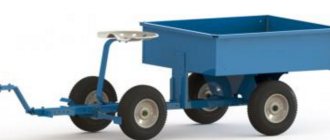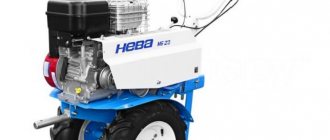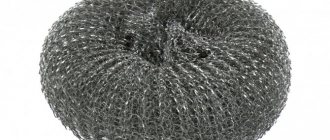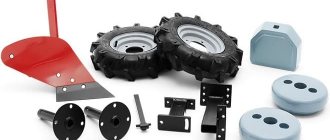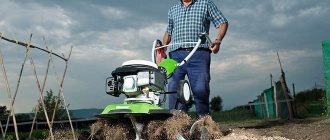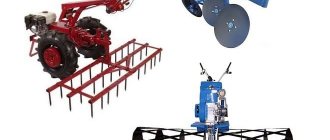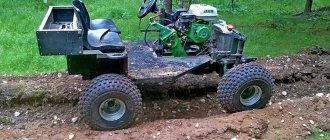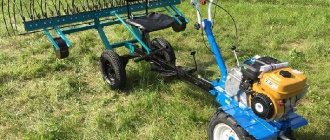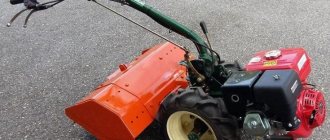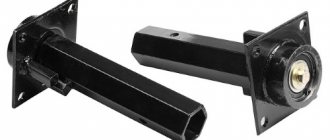Hubs for a walk-behind tractor are a necessary element to install pneumatic wheels or metal lugs on the unit. It belongs to the mounted type of equipment. Its main purpose is to attach pneumatic or metal wheels with hooks to walk-behind tractors.
In this article we will talk in detail about what a hub for a walk-behind tractor is and what its main functions are. We will also touch on the topic of how to make hubs for a walk-behind tractor with your own hands, using ready-made drawings and pictures for this.
Hub for walk-behind tractor with differential
The hub for a walk-behind tractor is the main component when operating such equipment. It is designed for attaching attachments to a walk-behind tractor intended for performing agronomic manipulations.
The hub can be used to attach equipment such as pneumatic wheels.
There are two types of hubs:
- ordinary;
- hub with differential.
It is generally accepted that the differential hub is universal for all types of walk-behind tractors. It makes it possible to simplify the maneuvers of equipment and is suitable for both a cart and a walk-behind tractor. The differential hub consists of a retainer and several bearings. To perform the turning maneuver, you just need to unlock the required lock. The hub with bearings is used for the walk-behind tractor and is universal for all walk-behind agricultural machinery. When using a hub with a differential, you will make your life easier and improve the functionality of the walk-behind tractor, thereby extending its service life.
Walk-behind tractors with wheels are standardly equipped with these elements, but it is not very convenient to remove them every time when it is necessary to attach attachments. Therefore, it is logical to get another pair. This will save your time and reduce wear on the main elements. Below you can see a diagram of how to make hubs for a walk-behind tractor with your own hands.
Walk-behind tractor wheel hub: current types
Currently on the market you can find:
- ordinary devices;
- differential hubs.
Moreover, the last element is in greatest demand, since it is considered universal. Hubs are necessary if walk-behind tractors are not equipped with a wheel unlocking function, and the turning/turning procedure itself is quite problematic. With the help of a differential for a walk-behind tractor, you can literally make one turn all the way, which increases the level of maneuverability. It locks one wheel, so independent wheel movement creates conditions for measured turns. Even without human intervention and the use of physical force, at the end of the row the unit can quickly turn 240 degrees and continue its work. Often, cultivators are standardly equipped with these parts, but removing them every time during operation is quite inconvenient, so it is advisable to immediately purchase another pair. This move will save the operator time and reduce the pressure exerted on the basic elements.
As for the classification by diameter, here are the following:
Moreover, hexagonal ones are presented in two versions: 24 and 32 mm.
Hubs for a walk-behind tractor: how to make it yourself?
The need for these devices for a walk-behind tractor is undeniable. Different types of such structural elements are used for motorcycles. They can be purchased on the walk-behind tractor market or made by yourself. This process will not be difficult if you follow the instructions exactly. It’s easy enough to make a hub for a walk-behind tractor with your own hands using the following drawing.
When making a part by hand, it is best to use the highest quality materials. There is a need for the element to be durable, since it bears a large load during operation.
Source
Features of application
Listen to the advice of professionals regarding the purchase of walk-behind tractors with hubs.
- When ordering hub parts for your unit, do not forget to send information about the type and model of the equipment, as well as about the wheels - for example, the so-called eighth hub will fit wheel 8.
- Usually, when purchasing a fully equipped walk-behind tractor, there is also one set of hub elements. Immediately purchase an additional 1-2 more - this will increase the comfort of working with various attachments; you will not have to change or rearrange the hubs when changing additional elements.
- If the purchased set contains pneumatic wheels, the presence of hub elements is mandatory.
For more information about hubs for walk-behind tractors, see the video below.
How to make a differential for a walk-behind tractor with your own hands?
Despite the fact that the differential for the walk-behind tractor has a rather simple design, before making it yourself you will need to prepare and study the drawings. They should indicate the dimensions of the mechanism spare parts and methods of fixing them in the device.
Practice shows that every homemade differential has a small rotation angle of the wheels in the free position. As a rule, this parameter does not exceed 250 °. This disadvantage is due to the fact that the design of the mechanism includes a transverse groove, which significantly reduces the power and efficiency of the design. Another significant disadvantage is the rapid wear of the parts of a homemade differential, especially if a large amount of dirt accumulates between them. In this regard, self-made differentials should be used for exceptionally light models of walk-behind tractors.
In order for a homemade differential to be more durable and effective, you should adhere to a number of rules:
- there is no need to leave too small a groove in the space between the bushing and the extension axle. If corrosion occurs, these parts will quickly stick to each other;
- in order to timely lubricate the differential without regularly disassembling it, you need to place a pressing oiler on the mechanism bushing;
- For the manufacture of extension cords, it is best to use carbon steel. As a result, the mechanism will be more reliable and, at the same time, not expensive. The video will tell you more about making the differential.
Making a differential for a walk-behind tractor is not a complicated procedure. By following all the recommendations listed, you will be able to assemble a durable mechanism that will quickly pay for itself with further use.
Purpose and varieties
The presence of such an important part as a hub can significantly improve the maneuverability of your unit, the quality of tillage and other agricultural operations.
There are 2 types of hubs for walk-behind tractor wheels.
- Simple or ordinary. Such parts are characterized by simplicity of design and rather low efficiency - they can only slightly improve the maneuverability of the unit, as a result of which they are gradually losing popularity.
- Differential. Suitable for almost all models of walk-behind tractors, which is why they are also called universal. Parts with a differential are necessary for models whose design does not provide for wheel unlocking and makes turning and turning maneuvers of the unit difficult. The same type of part with bearings serves to improve the maneuverability of wheeled devices.
The design of differential hubs is simple - they consist of a retainer and one or a pair of bearings. To turn the equipment, you need to remove the lock from the required side.
The diameter and cross-sectional shape of these parts can be different:
- round;
- hexagonal - 32 and 24 mm (parts with a diameter of 23 mm are also found);
- sliding
Round hubs can be of different diameters - 24 mm, 30 mm, etc., depending on the brand and model of the device for which they are intended.
The cross-sectional shape of hexagonal hub parts, as the name logically suggests, is a regular hexagon - a hexagon. Their purpose is a smoother transmission of torque to the wheelset of a walk-behind tractor and making it easier to perform turning maneuvers.
There are sliding hub elements made of 2 parts that fit into each other. Their purpose is the same as for other similar elements, plus they allow you to adjust the track width. This is done by moving the outer pipe along the inner one. To fix the required distance, special holes are provided into which fasteners are inserted.
Typically, the technical characteristics of the hub elements indicate the corresponding diameter of the transmission gearbox shaft, for example, S24, S32, etc.
Also, semi-differential hub elements can be distinguished as an almost separate type. Their operation is based on the principle of transmitting torque from the axle to the hub part using protrusions on these elements. The wheelset is not rigidly connected, which allows you to make a turning maneuver without a power reserve, almost on the spot.
For trailers, special reinforced hubs are produced - the so-called Zhiguli hubs. They are usually made from cast iron or steel of suitable grades.
The length and weight of parts can vary significantly.
Types and characteristics of hubs for walk-behind tractors
The hub for a walk-behind tractor is an important element of the design of an agricultural machine. Its presence, paired with an installed special attachment, significantly improves the quality of plowing the soil, hilling beds, planting potatoes, harvesting and other activities in the garden.
There are two types of hubs on sale.
Among them stands out:
- differential hub - this part is considered universal and can be mounted on all walk-behind tractors, regardless of their class and design features. Differential hubs are required for use on those walk-behind tractors whose factory equipment does not include a wheel unlocking mechanism, as well as for those models of equipment that cannot be freely deployed at the end of the cultivated bed. This walk-behind tractor wheel hub is equipped with bearings, which significantly increases the maneuverability of the unit:
- ordinary hub - a part of this type has a simpler design, but is less efficient in use. It only slightly improves the maneuverability of the walk-behind tractor, so every year it is in less and less demand among farmers.
Differential hubs, or semi differentials as they are also called, consist of one or a pair of bearings, as well as retainers. When using such a part, in order to turn the walk-behind tractor, it is necessary to disconnect the lock from the corresponding latch.
Depending on their diameter and shape, differential hubs for walk-behind tractors can be of the following types:
- round hub;
- sliding part;
- hexagonal hub - can have a diameter of 24 or 32 mm.
This kind of classification of semi-differentials allows the farmer to select the part that is optimally suited for installation on his walk-behind tractor and will bring maximum benefit when used.
Design and purpose of a walk-behind tractor differential
The main purpose of the walk-behind tractor differential is to distribute power more evenly between the wheels of the walk-behind tractor.
The differential will be especially useful when turning. To turn a walk-behind tractor, you usually need to put in a lot of effort, especially if the equipment has lugs and attachments. The differential allows for easier turning due to faster wheel rotation. Thanks to it, the wheels rotate faster than the one that occurs only due to the axle. For different models of walk-behind tractors, differentials have their own design features and differences. For example, for light Neva walk-behind tractors, differentials with a small wheel rotation angle (240°) are used. Also, due to the transverse groove, it has little strength; strong friction of the parts is observed inside the mechanism.
Motoblocks from Salut are equipped with differentials of a more complex design. They are distinguished by greater mass and wheel rotation angle (about 330°). The extension has bearings, which reduces the effort when turning.
For Farmer brand walk-behind tractors, differentials consist of two clutches, and control is carried out using levers on the steering wheel.
Options for power distribution mechanisms
Structurally, the simplest way to solve the problem arising from the rigid connection of the wheels is to use overrunning clutches, which allow the wheel to rotate faster than the axle driving it.
Overrunning clutches
This mechanism is well known in all its variations: both with a ratcheting mechanism (bicycle wheel hub) and with wedging rollers (electric starter bendix).
Overrunning clutches are also used in the power drive of a number of cars with plug-in axles. However, this solution has a characteristic feature: when cornering, the overrunning clutch is disconnected on the wheel running along the outer radius, as it tends to rotate faster than the drive shaft.
To make it easier to enter a turn, on the contrary, most of the torque should be transmitted to it.
This problem is solved in the classic gear differential , which distributes power in inverse proportion to the rotational resistance of the wheels.
But it is also noticeably more difficult to produce, and also requires forced full or partial blocking on off-road conditions, since otherwise it redistributes all the power to the slipping wheel.
Differential for a walk-behind tractor - how it works and what it’s capable of
Diary entry created by user CaimanTeh, 02/26/15 .188,
Recently, a video of the Caiman Vario walk-behind tractor with a snow thrower attachment was posted on YouTube. During the story about the features of winter use of the walk-behind tractor, “additional differentials” installed on the wheels were mentioned.
To demonstrate the differentials, Denis turned the walk-behind tractor back and forth. The demonstration was short, but this option interested the participants in the Pubert & Caiman Motor Tillers
In the topic, it seemed like they quickly figured out what these additional differentials were for a walk-behind tractor, but since the question arose, I decided to make a short photo report. After filming, the demonstration walk-behind tractor with a differential was full of gasoline and oil, so it was taken to the service room. It's cramped there, there's a lot of other equipment around, so we couldn't spin it. All I got from Caiman Vario was a photograph.
Differential for Caiman Vario walk-behind tractor
So, here are these differentials, or rather semi-differentials installed together with standard rubber wheels of size 4.00-8. (The set of two semi-differentials is called “Differentials with extensions for the VARIO/Q Junuor/Q Max walk-behind tractor” and has code R0101.)
The design of such differentials for walk-behind tractors (and walk-behind cultivators, by the way) is extremely simple:
- the wheel hub is not secured to the axle
- there are protrusions on the axle and hub (indicated by green arrows) that prevent the wheel from turning a full turn
How it works
During normal movement of the walk-behind tractor, the protrusion on the axle rests against the protrusion on the hub and transmits rotation to the wheel. In this case, both wheels will rotate simultaneously.
Tips for choosing a hub for a walk-behind tractor
On the open market you can always find a large selection of hubs designed for installation on various models of walk-behind tractors.
In order not to make a mistake when choosing a part, farmers should adhere to a number of certain rules:
- when ordering a hub for a walk-behind tractor, you should indicate the class and model of the agricultural implement;
- in most cases, when selling a walk-behind tractor, one set of hubs is included in its kit. In this case, when using attachments, there is no need to rearrange the hubs. This, in particular, applies to the lugs used on the walk-behind tractor. This feature will save a lot of time when working in the garden;
- If the walk-behind tractor is equipped with pneumatic wheels, then its delivery set will necessarily include hubs.
Useful tips and tricks
When using hub elements for a cultivator or walk-behind tractor, you need to remember the following rules. They will help improve the operation of these parts.
- When ordering a hub for a walk-behind tractor, be sure to indicate the type and model of the walk-behind tractor.
- Traditionally, one hub kit is sold complete with agricultural equipment. It is recommended to purchase an additional kit. Then, when working with different types of mounted agricultural equipment, there will be no need to rearrange the hub components. In particular, this applies to the use of lugs. This “trick” will save time.
- If the walk-behind tractor comes with pneumatic wheels, then the hub parts will also be included with this agricultural equipment.
Improvement of the chassis
The first thing users of a walk-behind tractor think about is how to make a cart with a seat for it. Using equipment in normal mode using levers requires the application of great physical effort. However, the use of a trailer reduces the stability of the vehicle. This problem can be eliminated by extending the wheelbase. This is done using extensions that are attached to the axle shaft with pins or bolts. Having solved the stability problem, the operator is faced with another issue: the unit is poorly controlled. The differential for the walk-behind tractor helps to give it good maneuverability. This device is made by analogy with components of passenger cars. Homemade unlockers for walk-behind tractors are made using ordinary household tools - an angle grinder, welding and a sharpening machine.
The low weight of the walk-behind tractor causes poor traction between the wheels and the ground. Slipping is a common occurrence when lifting virgin soil, working on wet ground or driving in snow. To avoid slipping, weights are attached to walk-behind tractors.
These devices are divided into the following categories:
- Wheeled. They are discs that are mounted on wheels or hubs. Disks are made monolithic from metal, concrete or hollow, filled with sand. The weight of wheel weights can be 30-70 kg.
- External. Made from any heavy material (steel, lead, concrete). Attached to the body using hooks or bolts. Some craftsmen weld a frame from a corner to the body. Sandbags, bricks, scrap metal and other heavy objects are placed in it.
You can improve the cross-country ability of a walk-behind tractor by installing lugs. The easiest way to make lugs is to make a rim from a strip of metal and weld blades onto it. The rim diameter should be larger than the rims and smaller than that of the tires. The rim is installed with flat tires. After the lug is installed, the wheel is inflated.
You can improve the transmission by installing a homemade variator on the engine. The system of belts and discs will allow you to smoothly change the speed of the unit, without jerking or vibration.
Making a hub - step-by-step algorithm
As in the case of a differential, to manufacture a hub for a walk-behind tractor, you will need to prepare drawings. A detailed diagram will make it possible to complete the work faster and avoid common mistakes.
The correct sequence of actions when making a hub is as follows:
- First you need to grind the workpiece. To do this, any metal part is taken and processed on a lathe;
- A fairly popular option is to make a flange and then weld it to a metal pipe or rod. When processing a part, you should be extremely careful and observe the dimensions indicated in the selected drawings;
- It should be remembered that during operation the hub will be subject to constant loads, which is why it is better to choose a reliable material for making it yourself - for example, hardened steel.
After manufacturing the hub, it can be installed on the walk-behind tractor and tested in operation. You should not place high loads on the part immediately after installing it on the unit - otherwise it may become deformed. It is best to walk with the walk-behind tractor several times on a flat surface in the yard, turning the car around several times. After this, the hub will finally fall into place, and the unit with it can be used for work in the garden. A self-made differential or hub can be successfully used to equip Neva brand walk-behind tractors. The design of the units of this brand allows you to easily install the part, and, if necessary, remove it easily and quickly.
Reviews of the UGRA NMB-1N9 walk-behind tractor
Motoblocks with the Ugra differential are very popular among consumers. This is due to the not so high cost, which is equal to 54,000 rubles. The equipment is equipped with a metal tank, a reduction gear, and the ground clearance is 170 cm.
The maximum speed, according to buyers, is quite high. In first gear you can move at a speed of 3.61 km/h, in this case we are talking about pneumatic wheels, while if you install lugs, the speed will be reduced to 3.5 km/h. In third gear, the walk-behind tractor increases speed to 8.52 km/h on pneumatic wheels and to 8.25 km/h on lug wheels.
The power of the equipment is 6 liters. s., and the fuel tank holds 3.6 liters. The transmission is represented by a manual gearbox, as well as a gear reducer. The equipment does not weigh that much, which is what buyers like, the device weighs only 85 kg.


